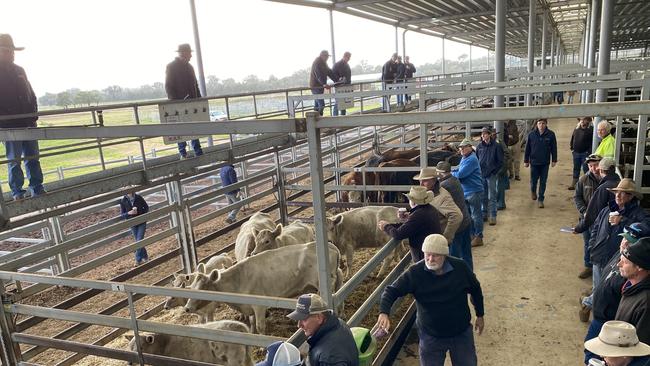Australian cattle market: honeymoon over for producers
Livestock producers are taking hit after hit as markets slide coming into winter, and profit margins are erased.
The honeymoon for Australia’s livestock industry is well and truly over as almost every sector takes big hits to returns.
Producers are reeling as cattle, sheep, lamb and wool prices fall weekly, stripping profits from many operations.
In the past week:
THE benchmark Eastern Young Cattle Indicator dropped to 582c/kg on Monday — down 35c/kg in a week and whopping 48 per cent on this time last year.
THE eastern states trade lamb indicator fell to 564c/kg, down 213c/kg or 38 per cent down on 12 months ago.
WOOL’S Eastern Market Indictor sunk to 1214c/kg clean, 15 per cent lower than last year.
Market confidence has been rocked by one prediction the EYCI — a gauge of restocker, feeder and processor interest — will dive to below 550c/kg carcass weight by Christmas.
Agent John Atkins from Atkins Marketing Livestock at Albury said some clients at Wodonga store cattle sale last week received what they paid for cattle a year ago.
“I know myself I have steers I bought for more than $2000 that I haven’t sold yet and keep waiting for the prices to lift,” Mr Atkins said.

At Wodonga last week, 845 steers averaged 332c/kg liveweight — a 53c/kg drop from the 385c/kg average achieved for 3574 steers at the start of this month.
It was a similar tough slog at prime cattle sales on Monday, with cows up to 45c/kg cheaper at Pakenham, feeder steers down 30c/kg at Wagga Wagga NSW and lambs up to $30 a head cheaper at Bendigo.
Meat and Livestock Australia managing director Jason Strong said a return to drier seasonal conditions with the chance of below-average rainfall during winter was expected to drive a higher turnoff of stock.
“If this increase in supply cannot be managed by the processing sector due to a shortage of labour, repercussions for the broader industry will be felt throughout the market,” Mr Strong said.
“Although there is the potential for a global recession in the near future, current global dynamics point towards continued demand for Australian beef in established and emerging markets.”
Mr Strong said producers were currently quitting stock as they offloaded numbers heading into winter due to concerns of a drier season.
“Overall we’re seeing the market do what it normally does and producers should not panic due to the falling indicator price,” he said.
“We caution against comparing the market to 12 months ago or against five-year averages because of how strong it was. This is not unexpected and we’re back to less volatile prices and seasonal conditions determining outcomes.”
RMA general manager Chris Howie also urged producers to be calm, saying that three years of stellar seasons had allowed the livestock inventory to increase with prices the result of a “1990s style supply glut”.

He said the slowing of live exports — cattle from northern Australia and sheep from Western Australia — was also having an impact on prices.
“When live export is operating fully, it is sucking a physical unit out of the system, and so those numbers (from slower live export) are now feeding back into already swelled numbers,” Mr Howie said.
Floods in northern Australia had also slowed the turnoff of heavy cattle, and he estimated processors had two years of bullock supply on offer which was also flattening demand.
Mr Howie said a lack of feed meant it was difficult to play the market this season but he feels the market may have bottomed out.
Meanwhile, Auctionsplus recorded a 38 per cent clearance for its eastern states sale last week for the more than 14,000 cattle offered and in its May cattle outlook, Auctionsplus senior analyst Damien Thomson said the dive in cattle prices had “taken some in the industry by surprise”.
“While the fall from historical price records was considered inevitable, the speed and severity of the decline was not expected,” Mr Thomson said.
And thanks to a much larger cattle herd than expected, Mr Thomson said it was likely prices would fall for the rest of the year.
“The EYCI is expected to be below 550c/kg carcass weight in December,” Mr Thomson said.
“This would be well below the 10-year average of 617c/kg and just below the median price of the past 10 years of 562c/kg.”




